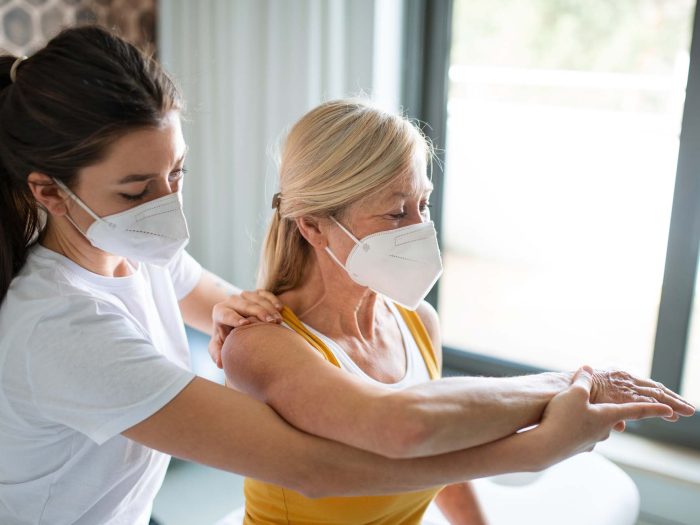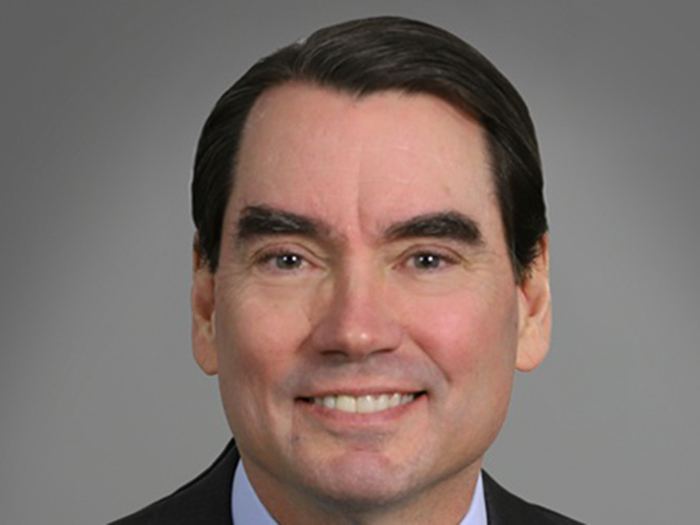On the Long Road to Recovery from COVID-19, Physical Therapy Is Key to Return-to-Work for Millions

COVID-19 continues to be uncharted, complex territory. Some people who contract the virus — the “long haulers”— experience lingering symptoms long after a COVID-19 test reads negative. Many companies with workers who contracted the virus on the job are turning to physical therapy to support their staff.
Although physical therapists have played a central role in paving the road to recovery for COVID-19 patients from hospital ICU settings to clinics, physical therapy may not be the first approach that comes to mind when thinking of how to address lingering symptoms like fatigue, labored breathing, headaches, dizziness, joint pain, and muscle pain.
Recent studies, however, have shown promising results. Physical therapy can play a substantial role in helping people recover from post-acute sequelae of COVID-19 (PASC) — commonly referred to as “long COVID” — so they can focus on returning to work.
A 15-study review by the National Institutes of Health (NIH) about the effects of COVID-19 on occupational health concluded that physical therapists must continue to be involved in the “battle against this illness” to help patients recover their physical function and return to work as quickly, safely, and effectively as possible.
“Physical therapists have helped shape what these programs should look like, but we’re also continually plugged in to the emerging data to understand if they need to evolve or be different,” said Michelle Despres, vice president of physical therapy and national clinical leader for One Call.
A Long Haul for Millions
COVID-19 has already had a major impact on society and the economy – especially since active workers in the industry and service sectors have been especially vulnerable to the virus, according to the NIH.
A report by the COVID-19 Patient Recovery Alliance highlighted that as of April 2021 at least 30 million Americans had been infected by the virus causing COVID-19, with some estimates reaching up to 100 million.
For 10-30% of survivors who had an acute infection, recovery may involve a “protracted period of uncertainty” as they address ongoing clinical needs that appear to be chronic.

Michelle Despres, vice president of physical therapy and national clinical leader, One Call
Given this range of percentages, somewhere between three to nine million individuals could experience persistent symptoms for anywhere from 12 weeks to nine months, as found in a research letter by the Journal of the American Medical Association.
“What we know is that this virus can attack any major system in the body and that it does vary amongst individuals,” Despres said.
“The most serious long-term complications are categorized under cardiovascular, respiratory, neurologic, and psychiatric,” with more unknowns yet to come, she added.
A symptom survey done by Indiana University illustrated at least 50 symptoms individuals face as they navigate long COVID, with the top five being fatigue, muscle or body aches, shortness of breath, difficulty concentrating, and an inability to exercise or be active.
But the leading symptom across all studies that can have significant impact on a person’s ability to work, Despres confirmed, is fatigue. “Fatigue is usually number one.”
The Main Recovery Treatment Available
The NIH has found that physical therapists can help people get back to work as they “contribute to the prevention and rehabilitation of impairments caused by the illness.” They assist with “functional independence and facilitating individuals’ reintegration into society and the job market.”
For some people experiencing PASC, physical therapy has also been the most accessible treatment option available. At least this has been the case in many states across the South as seen by Results Physiotherapy, part of the Upstream Rehabilitation network of brands.
“We identified that for most PASC patients, physical therapy was the only active intervention they had received,” said Stephen Connolly, director of clinical quality for Results Physiotherapy, “and they were very grateful for the care they received.”
Though most of the physical therapy provider’s long COVID patients were referred by primary care physicians, Connelly found that “many patients were not receiving any active medical care, and many came to us through direct access.”
Results Physiotherapy began offering its recovery program in the fall of 2020 when, as Connolly found, “it was apparent that PASC was affecting a significant number of those infected with COVID-19.”
“Due to the wide-ranging presentation of PASC patients with multiple systems and organs affected, we avoided a prescriptive, rigid program,” Connelly said. “Instead, we included safety parameters around vital signs and exercise response and encouraged our clinicians to apply a clinical reasoning process to tailor make a care plan.”
Clinically, Connolly said, “those with respiratory symptoms responded very well to manual therapy around the thorax, diaphragmatic breathing training, incentive spirometry, and progressive conditioning.”
For those patients experiencing a high incidence of headaches, Connolly found they “typically responded well to gentle manual therapy in the upper cervical spine.”
Results Physiotherapy also saw “several challenging presentations of balance deficits, peripheral nerve dysfunctions, and cognitive dysfunction.”
With a network of more than 200 locations across the Midwest and the South, CORA Physical Therapy has also seen successful results with PASC patients.
“By focusing on the postural problems that have developed from being hospitalized and sedentary for so long,” CORA has been supporting patients with “chest expansion and improved scapulo-thoracic strength,” according to Dr. Nicholas Pahl, clinic manager for CORA in Sarasota, Fla.
“We have also seen great success in utilizing dry needling for patients that present with significant muscle guarding and spasms in their thoracic spine and shoulder girdle regions with post treatment reports of ease in breathing and symptom reduction,” even after a single treatment, he shared.
Uniquely Qualified for the Job
Given the unique qualifications of physical therapists to assess physical and functional impairments and monitor, measure, and collect patient progress data, it’s no surprise they play a pivotal role in COVID-19 recovery.
“Physical therapists are movement experts,” Despres said. “We’re highly qualified to identify, quantify, and treat fall risk conditions, such as fatigue, post-exertional malaise or poor endurance, exercise capacity, and balance.”
Physical therapists can treat strength deficits and mobility problems, provide functional improvements, and even assess biometric and orthostatic measurements, such as heart rate, blood pressure, pulse oximetry.
Throughout care, Despres said, therapists can monitor the right “pieces and components,” to ensure patients are “getting the right outcomes.”
Outcomes like those found in data from Select Medical, an outpatient physical therapy provider that launched its Recovery and Reconditioning Program in response to the pandemic in May 2020.
A study by the Centers for Disease Control and Prevention (CDC) evaluating Select Medical outpatient data showed that when compared to a control group of patients in a cancer rehabilitation program who had not contracted COVID-19, patients recovering from COVID-19 reported worse overall physical health, pain, and difficulty with physical activities.
Post–COVID-19 patients also had “worse physical endurance, compared with control patients” with 92% having diagnoses potentially related to post-COVID-19 conditions including “weakness, malaise, fatigue, respiratory failure with hypoxia, and gait abnormalities,” according to the CDC report.
Patients recovering from COVID-19 had higher utilization of healthcare and longer therapy duration as well.
For Select Medical, Alan Evans, vice president of outpatient division education said, “To date, more than 3,000 patients have been treated in their recovery from COVID-19 at our outpatient rehabilitation centers.”
“Currently our data shows that more than 80 percent of patients report meaningful improvement in their health-related quality of life after completing the program, even with the highly variable long-term sequelae seen amongst this population,” he added.
Physical Therapy May Be Underutilized in Workers’ Compensation
Despite promising outcomes and published reports from the CDC and NIH, physical therapy may still be an underutilized treatment option for long haulers in some regions.
In many states, it has been difficult for a COVID-19-related illness acquired on the job to qualify for workers’ compensation. Even though the hazard level of working conditions has soared – especially for workers in health care, mass transit, and grocery stores – more hazardous working conditions have not guaranteed a COVID-19 infection would be covered under workers’ compensation, as pointed out by the National Conference of State Legislatures.
“We anticipated we may get some worker’s compensation PASC cases, initially getting advice that the burden of proof for an infection contracted at work may be a barrier to patients obtaining care through this route,” Connelly found.
Yet, “relatively few of our referrals were from workers’ compensation – less than five percent of the referrals we’ve had into the program,” he said.
Evolving with the Needs of Patients
For the past 19 months, physical therapists have been on the frontlines helping people find a way back to their lives after facing COVID-19. As millions of people with long COVID aim to restart work, physical therapists will be there to support their transition.
As a co-author of the Clinical Guidance to Optimize Work Participation After Injury or Illness by the Academy of Orthopaedic Physical Therapy (APTA), Michelle Despres affirmed that physical therapy will undoubtedly be helpful to long COVID patients navigating their return to work.
The implementation of physical therapy has the potential to “benefit the worker, the clinician, and the employer in terms of achieving return-to-work goals, managing the associated costs, and improving productivity,” as concluded by the APTA recommendations.
Thus far in the pandemic, physical therapy programs have evolved to address PASC symptoms as they emerge, Despres said. For One Call, “we will continue to tailor our programs and partnerships to help long haulers regain strength, restore function, and ultimately, transition back to work,” Despres said. &










